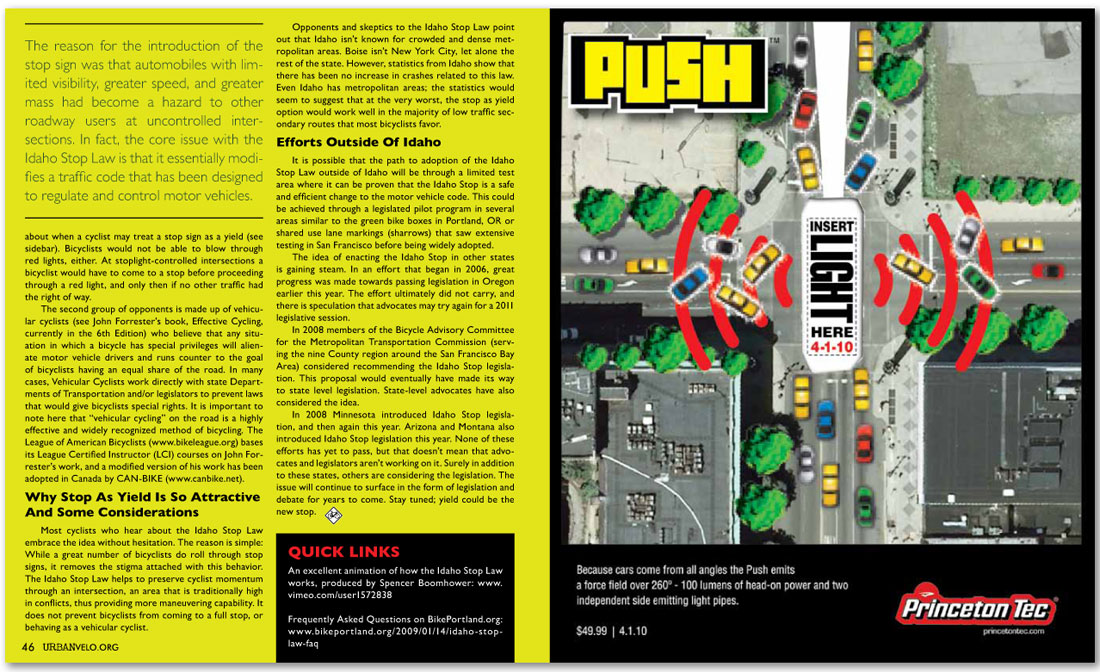


about when a cyclist may treat a stop sign as a yield (see sidebar). Bicyclists would not be able to blow through red lights, either. At stoplight-controlled intersections a bicyclist would have to come to a stop before proceeding through a red light, and only then if no other traffic had the right of way.
The second group of opponents is made up of vehicular cyclists (see John Forrester’s book, Effective Cycling, currently in the 6th Edition) who believe that any situation in which a bicycle has special privileges will alienate motor vehicle drivers and runs counter to the goal of bicyclists having an equal share of the road. In many cases, Vehicular Cyclists work directly with state Departments of Transportation and/or legislators to prevent laws that would give bicyclists special rights. It is important to note here that “vehicular cycling” on the road is a highly effective and widely recognized method of bicycling. The League of American Bicyclists (www.bikeleague.org) bases its League Certified Instructor (LCI) courses on John Forrester’s work, and a modified version of his work has been adopted in Canada by CAN-BIKE (www.canbike.net).
Why Stop As Yield Is So Attractive And Some Considerations
Most cyclists who hear about the Idaho Stop Law embrace the idea without hesitation. The reason is simple: While a great number of bicyclists do roll through stop signs, it removes the stigma attached with this behavior. The Idaho Stop Law helps to preserve cyclist momentum through an intersection, an area that is traditionally high in conflicts, thus providing more maneuvering capability. It does not prevent bicyclists from coming to a full stop, or behaving as a vehicular cyclist.
Opponents and skeptics to the Idaho Stop Law point out that Idaho isn’t known for crowded and dense metropolitan areas. Boise isn’t New York City, let alone the rest of the state. However, statistics from Idaho show that there has been no increase in crashes related to this law. Even Idaho has metropolitan areas; the statistics would seem to suggest that at the very worst, the stop as yield option would work well in the majority of low traffic secondary routes that most bicyclists favor.
Efforts Outside Of Idaho
It is possible that the path to adoption of the Idaho Stop Law outside of Idaho will be through a limited test area where it can be proven that the Idaho Stop is a safe and efficient change to the motor vehicle code. This could be achieved through a legislated pilot program in several areas similar to the green bike boxes in Portland, OR or shared use lane markings (sharrows) that saw extensive testing in San Francisco before being widely adopted.
The idea of enacting the Idaho Stop in other states is gaining steam. In an effort that began in 2006, great progress was made towards passing legislation in Oregon earlier this year. The effort ultimately did not carry, and there is speculation that advocates may try again for a 2011 legislative session.
In 2008 members of the Bicycle Advisory Committee for the Metropolitan Transportation Commission (serving the nine County region around the San Francisco Bay Area) considered recommending the Idaho Stop legislation. This proposal would eventually have made its way to state level legislation. State-level advocates have also considered the idea.
In 2008 Minnesota introduced Idaho Stop legislation, and then again this year. Arizona and Montana also introduced Idaho Stop legislation this year. None of these efforts has yet to pass, but that doesn’t mean that advocates and legislators aren’t working on it. Surely in addition to these states, others are considering the legislation. The issue will continue to surface in the form of legislation and debate for years to come. Stay tuned; yield could be the new stop.
Princeton Tec
QUICK LINKS
An excellent animation of how the Idaho Stop Law works, produced by Spencer Boomhower: www.vimeo.com/user1572838
Frequently Asked Questions on BikePortland.org: http://bikeportland.org/2009/01/14/idaho-stop-law-faq